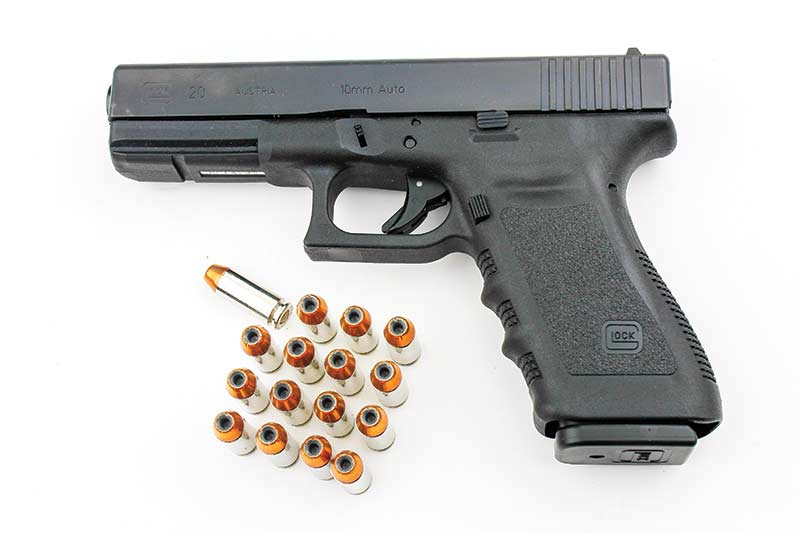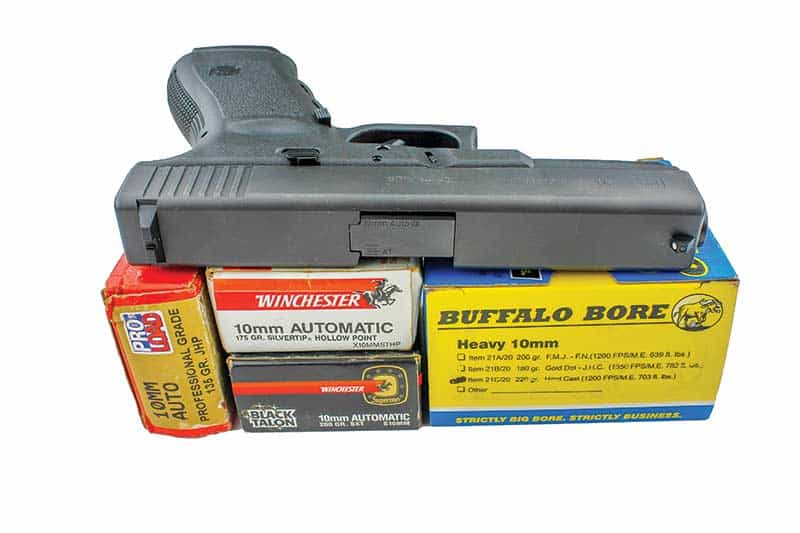THE RISE, FALL — AND RISE — OF THE 10MM
In the early 1980s, the combined wisdom of Jeff Cooper and Whit Collins created the 10mm Auto cartridge. Dornaus & Dixon introduced their Bren Ten pistol as Norma, their initial commercial loading for it, a 200-grain FMJ bullet running at 1,200 feet per second at 37,500 lbs. per square inch pressure. The Bren didn’t survive, but three things happened to save the 10mm — 1) Colt chambered their Government Model for it as the Delta Elite, keeping it available to shooters; 2) The FBI, briefly, adopted the 10mm in the form of the Smith & Wesson Model 1076; and 3) Folks who were in the land of big, people-eating bears realized large-diameter bullets with enhanced velocities were good prevention against becoming Purina Bear Chow, with more bullets giving you more chances.
Bare logic for bear defense: The GLOCK 20, the most popular 10mm pistol, holds 15+1 rounds.
The first-in-class 10mm — Mas’ personal Bren Ten.
Police and Defense History
When the FBI talks, cops listen: The FBI Academy is to law enforcement as Harvard Business School is to business. The state troopers of Virginia and Kentucky adopted the S&W 10mm as did a number of smaller LE agencies. However, the FBI load for the 10mm was a 180-grain JHP around 1,000 feet per second and in 1990 S&W and Winchester jointly introduced the .40 S&W with the same ballistics in a shorter cartridge, allowing both smaller pistols and greater cartridge capacity. The .40 S&W became a national police standard faster than any preceding cartridge and pushed the 10mm off-stage. The same was also true in the armed citizen sector. The popularity of the 10mm quickly faded in both arenas.
The original JHP load for the 10mm was a 170-grain at 1,300 foot-seconds from Norma. It tended to shoot through and through the perpetrator without fully expanding and distributing its inherent power. By the time we had loads like the Cor-Bon 135-grain at 1,400 feet per second and what became the most street-proven load, the Winchester Silvertip with a 175-grain bullet at 1,290 feet per second — actually exceeding the .41 Magnum version of the Silvertip by 40 fps — the tide of the .40 S&W had swept the 10mm largely out of the picture and out of the “street performance data pool.”
Personal Experience
I was one of the first who reported in the gun press that in early shootings of bad guys, the 10mm just hadn’t done so great because of the loads in early use. Some critics said I was just bitterly expressing NIH (Not Invented Here) syndrome. Au contraire. The Police Standards and Training Bureau in my state told me I was the first cop within their borders who had registered a department qualification with the 10mm (a Bren Ten) and actually carried it on duty. I stopped carrying it when I realized the ideal ammo for The Job wasn’t available then and spare magazines weren’t going to be forthcoming, so I went back to a .45. I almost took a custom Delta Elite to Africa in late 1987 but chose a .44 Magnum instead because ammo wouldn’t be available there, and I wanted more power. I never had occasion to regret the choice.
In 1998, I had two landmark experiences. I was named Outstanding American Handgunner of the Year and my younger daughter Justine and I won the National Sub-Junior Team Handgun Championship. It was parent/child: Justine, 13, shot a custom Springfield Armory .45 with +P loads and I shot my Mark Morris Custom Carry-Comp Colt Delta Elite 10mm with Black Hills 165-grain JHP at 1,300-some feet per second. If I could keep only one of those moments, it would have been me and my kid, and I still own and cherish the Morris 10mm. I carried it often when I was traveling with my family: its flat trajectory and 100-yard power retention made it the equivalent of a .40 caliber carbine. I never taught with one, though — on the road, you can’t replenish less-popular calibers with your particular choice of ammunition.
The peak of 10mm popularity came in Alaska. The state’s super-trooper Jeff Hall — gunfight winner, master martial artist and top-level firearms instructor — once said with tongue only slightly in cheek the Ruger Super Blackhawk .44 Magnum was the official Alaska outdoorsman’s handgun, but today, gun dealers in Alaska tell me the GLOCK 20 autoloader in 10mm has taken over the role. The deep penetration harming the 10mm’s performance in its original police/self-defense loads turns out to be just what you need when attacked by giant bears. It has proven itself such in some documented human-against-raging bruin shootings.
I presently have five 10mms in my armory — two are S&Ws, a Model 1026 decocker-only double action I won in a match and a shorter-barrel Model 1076 I acquired as an exemplar gun for a case I did as an expert witness for an ex-FBI employee. The Morris Custom Colt, of course, remains. There is a rugged GLOCK 20 there, with fixed sights, and a Springfield Armory XDM with 5.25″ barrel and adjustable sights. When I actually need a 10mm, it’s either the Springfield or the Morris Custom because their adjustable sights allow me to dial in for point of aim/point of impact with whichever of the wide variety of 10mm loads I’ve chosen for the given purpose.
The 10mm rose, and fell, and rose again and I think it’s here to stay for several good, often special purpose, reasons.





